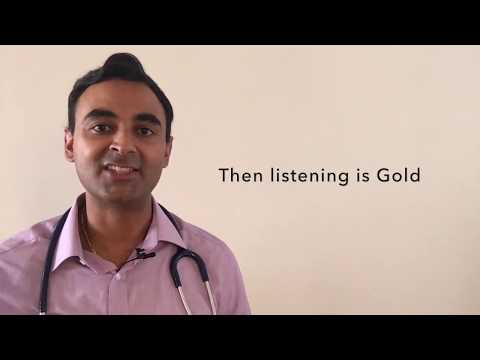Communication Tips Every Medical Assistant Needs to Know
Contents [show]
Medical assistants need to have strong communication skills to be successful in their roles. Check out these tips to help you improve your communication skills.
Checkout this video:
Introduction:
Communication is an important skill for Medical assistants They need to be able to communicate effectively with patients, doctors, and other members of the healthcare team. There are a few specific things that Medical Assistants can do to improve their communication skills.
Some medical assistants may feel like they need to be “perfect” when they communicate with patients. However, it is important to remember that patients are not looking for perfection. They just want to be respected and treated like human beings. Communication is not about being perfect; it is about being respectful and understanding.
Here are a few tips that every medical assistant can use to improve their communication skills:
1) Listen more than you speak.
2) Ask questions when you do not understand something.
3) Use clear and concise language.
4) Do not interrupt others when they are speaking.
5) Avoid using jargon or technical terms that patients may not understand.
6) Show empathy and understanding towards patients.
7) Respect the privacy of patients and keep confidential information confidential.
8) Take time to explain things to patients if they do not understand.
9) Follow up with patients after appointments or procedures to see how they are doing.
The Importance of Good Communication:
As a medical assistant you will be the bridge of communication between the doctor and the patient. It is important to know how to communicate with people from different walks of life, as well as how to communicate effectively with your co-workers. Below are some tips on how to communicate effectively.
Listening:
One of the most important aspects of communication is listening. When you are talking to a patient, it is important to listen to what they are saying and not just hear the words that they are saying. Pay attention to their body language and cues, as this will give you clues as to how they are feeling. If you are talking on the phone, pay attention to the tone of their voice. Is the person agitated or upset? If so, try to calm them down by speaking in a soothing tone.
Asking Questions:
Another important aspect of communication is asking questions. When you are talking to a patient, make sure that you understand what they are saying by asking questions. This will help avoid miscommunication and misunderstandings. Asking questions also shows that you care about what they are saying and that you want to help them.
Clarifying:
If you are unsure about something that a patient has said, it is important to clarify what they mean. This can be done by repeating back what they have said or by asking them to elaborate on what they meant. Clarifying will help ensure that you have correctly understood the situation and that everyone is on the same page.
The Different Types of Communication:
There are four different types of communication: verbal, nonverbal, written, and emotional.
Verbal communication is the act of speaking. This is the most common type of communication and can be either formal or informal. Formal speech is usually reserved for more serious occasions, like work meetings or classrooms, while informal speech is more casual, like conversations with friends.
Nonverbal communication is any type of communication that doesn’t involve words. This can include body language, like facial expressions and hand gestures, as well as eye contact. Nonverbal cues can be either intentional or unintentional, but they always send a message.
Written communication is any kind of communication that’s put down in writing. This can include things like emails, text messages, and evenposters or billboards. Written communication is a great way to communicate a clear message without misunderstood.
Emotionalcommunication is the act of communicating through emotions. This can be done through body language, facial expressions, and tone of voice. Emotionalcommunication can be either positive or negative, but it’s always sincere.
The Do’s and Don’ts of Communication:
Good communication is essential for any medical assistant You will be interacting with patients, doctors, and other medical staff on a daily basis, so it’s important to know how to communicate effectively. Here are some Dos and Don’ts to keep in mind:
DO:
-Be professional. This includes being polite, respectful, and positive.
-Listen carefully and attentively.
-Communicate clearly and concisely.
-Make sure your nonverbal communication (body language, facial expressions, etc.) is positive.
-Ask questions if you need clarification.
DON’T:
-Interrupt others when they are speaking.
-Use jargon or technical terms that the other person may not understand.
-Talk down to or patronize the other person.
-Overcommunicate or babble. Keep your messages short and to the point.
-Ignore or dismiss the other person’s nonverbal cues (body language, etc.).
The Different Modes of Communication:
There are four main modes of communication: verbal, nonverbal, written, and emotional. Each one plays an important role in how we interact with others and in how we understand the world around us.
Verbal communication is the use of words to exchange information. This can be done through face-to-face conversation, over the phone, or via video conferencing. It is important to be clear and concise when communicating verbally, as misunderstandings can easily occur.
Nonverbal communication is the use of body language, eye contact, and other cues to convey information. It can be just as important as verbal communication, as it can help to reinforce or contradict what is being said. For example, if someone says “I’m not angry” but has a angry facial expression and is clenched their fists, their nonverbal cues are indicating that they are actually angry.
Written communication is the use of text to exchange information. This can be done through email, instant messaging, social media, or even traditional letter-writing. It is important to be clear and concise when communicating in writing, as misunderstandings can easily occur.
Emotional communication is the use of emotions to exchange information. This can be done through facial expressions, body language, tone of voice, or even just through the way we interact with others. It is important to be aware of our own emotions and those of others in order to effectively communicate.
The Barriers to Effective Communication:
When it comes to communication in the medical field, there can be a lot of potential barriers. Here are some common barriers to effective communication and how you can overcome them:
-Lack of eye contact: One barrier to effective communication is lack of eye contact. This can make it difficult to build rapport and trust with the person you are speaking with. To overcome this, try to make eye contact when speaking with patients and co-workers.
-Poor body language: Another common barrier to effective communication is poor body language. This can include things like crossed arms, slouched posture, or avoiding eye contact. To overcome this, try to have open body language and make sure you are facing the person you are speaking with.
-Avoiding difficult conversations: It can be tempting to avoid difficult conversations, but this can actually lead to more problems down the road. If you need to have a difficult conversation, try to do it in a private setting and focus on staying calm and respectful.
The Importance of Listening:
As a medical assistant you will be the one who communicates between the patient and the doctor. This communication is vital to provide the best possible care for the patient. It is important to remember that listening is just as important as speaking when it comes to communication. Here are some tips to remember when you are communicating with patients:
• Listen attentively – give the patient your full attention and do not interrupt them.
• Repeat back what you have heard – this will help to ensure that you have understood what the patient has said correctly.
• Ask questions – if there is anything that you do not understand, make sure to ask questions so that you can clarify.
• Be respectful – show respect for the patient’s privacy and personal preferences.
By following these tips, you can ensure that you are providing the best possible care for your patients by being an effective communicator.
The Different Types of Listening:
Most people think of listening as a passive activity, something we do without thinking. However, there are different types of listening that require different levels of engagement and attention. In this article, we will explore the different types of listening and how they can be applied in a medical setting.
There are four main types of listening:
1. Active Listening – This type of listening involves taking in the whole message that is being communicated, both verbally and non-verbally. It requires being fully present and engaged with the speaker, making eye contact and responding appropriately. This type of listening is important in building relationships and trust.
2. Reflective Listening – Reflective listening is a skill that allows you to repeat back what you have heard to the speaker, in your own words. This type of listening helps to ensure that you have understood the message correctly and can be helpful in diffusing difficult conversations.
3. Empathetic Listening – Empathetic listening requires that you put yourself in the shoes of the speaker and understand their feelings and emotions. This type of listening can help build trust and rapport as well as provide a deeper level of understanding for both parties involved.
4. Critical Listening – Critical listening involves taking in information and evaluating it objectively, without letting your own biases or opinions get in the way. This type of listening is important in making sound decisions and solving problems effectively.
The Do’s and Don’ts of Listening:
Being a good listener is crucial for medical assistants. You will often be the first person a patient speaks to when they come into the office, and it’s important that you make a good impression. Patients want to feel like their concerns are being heard, and they need to be able to trust you with confidential information. Here are some tips to help you become a better listener:
Do:
-Make eye contact with the person you are speaking to.
-Nod your head occasionally to show that you are following along.
-Try to maintain an open body posture.
-Avoid distractions like cell phones or other electronic devices.
-Use verbal cues like “uh huh” or “I see” to acknowledge what the other person is saying.
-Repeat back what you have heard to make sure you understand.
-Ask questions if you need clarification.
Don’t:
-Interrupt the speaker.
-Finish the speaker’s sentences for them.
-jump to conclusions before the speaker has finished talking.
-Be afraid to take notes if it will help you remember what was said later on.
Conclusion
We hope you enjoyed reading this article. As a medical assistant, communication is key to success. Good communication with patients, doctors, and other staff members can make a big difference in the quality of care a patient receives.
There are many ways to improve your communication skills. We encourage you to keep learning and practicing, so that you can be the best medical assistant you can be.






